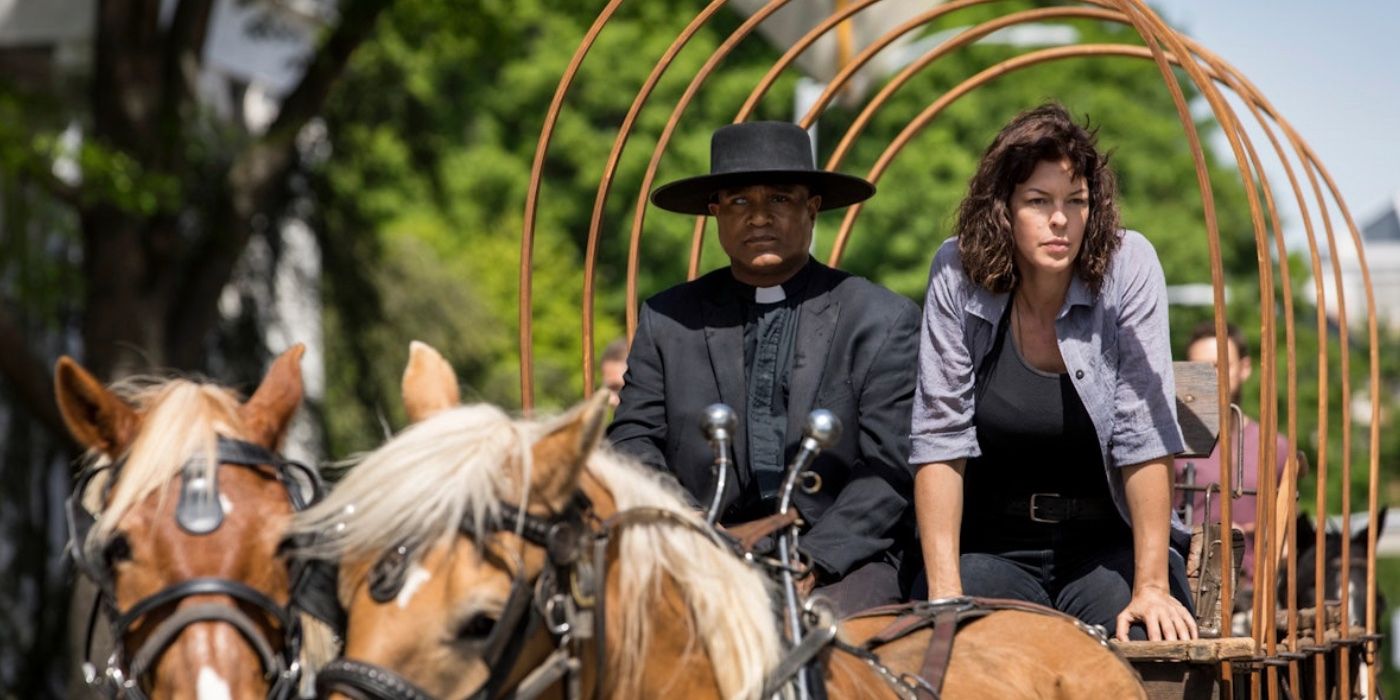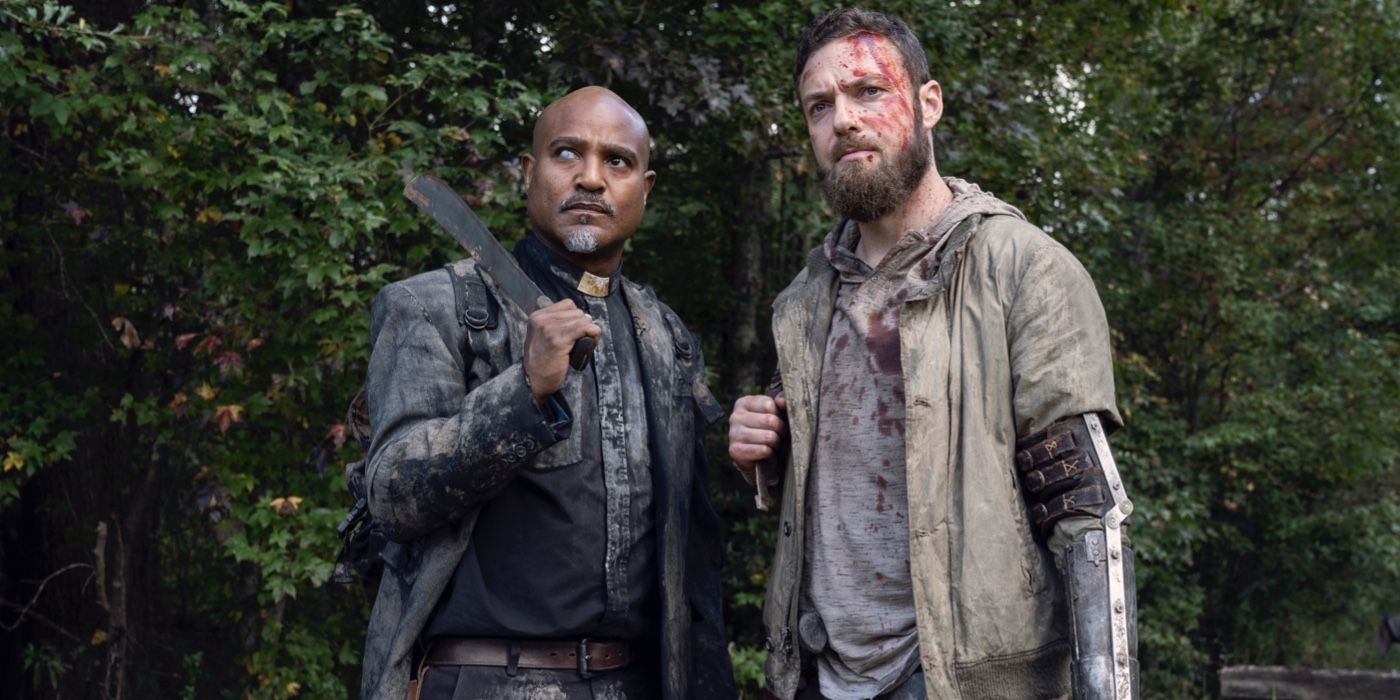One of the upsides of a television series that lives beyond a decade is watching characters age out of their pasts. Airing on AMC for 11 seasons and 12 years, The Walking Dead saw only two Season 1 characters live until the very end: Daryl Dixon and Carol Peletier. (Rick Grimes and Morgan Jones only lived on in their respective spinoffs.) These main characters got the cream of the crop treatment, leaving some side characters (namely, the Commonwealth residents) to get mediocre arcs. However, the golden standard for a supporting character’s transformation belongs to Father Gabriel Stokes.
The ensemble cast of The Walking Dead hardly allowed many supporting characters to stand out on their own. Very rarely, a few made their case as a worthy character to keep an eye on. Father Gabriel’s contradictory introduction to Rick’s hostile group in Season 5 told one or two stories: Either this man is going to die very soon, or he’s in for a long, wild run. Unlike his shortened comic book run, the TV show’s version of Father Gabriel went through hell and back to make it to the very end, rightfully earning his spot as a survivor of the zombie apocalypse.
Gabriel Evolved From a Cowardly Liar to a Valiant Leader







Kicking and crying at walkers on top of a boulder is a rough way to kick-start any character’s story on The Walking Dead. Not to mention, this was just after Rick’s group survived a community of cannibals and a horde of walkers flooding Terminus. But The Walking Dead wanted to establish that where there were cannibals like Gareth and experienced survivors like Rick, there were people who were living off luck. In Season 5, Episode 2, “Strangers,” Gabriel is met with instant cynicism by Rick and others because of his timidity.
Rick’s reluctance to trust Gabriel stemmed from fear of repeating history by trusting people too soon, belief that Gabriel was a cannibal and hatred that Gabriel took the easy way out to live. Rick and Sasha both had a right to suspect Gabriel but for the wrong reasons; he wasn’t a cannibal, but he was a selfish coward. He banished people from his church at the onset of the apocalypse who were killed by walkers as a consequence. Gabriel represented hypocritical religion at its finest: love thy neighbor until it’s every man for himself. Gabriel hit some rough patches from there.
Despite Rick, Michonne and Carl welcoming him into his group, he betrayed their trust by telling Deanna they were sent by the devil to tear down Alexandria. But it also took people like Carl Grimes to see that Gabriel was no different from everyone else, just because he held himself to a higher standard as a priest. That period of The Walking Dead was everyone’s lowest point, including Gabriel’s. Beginning in Season 6, he searched for forgiveness from those he betrayed and accepted that hard actions had to be taken to survive. He could no longer pretend that the old rules still applied to the world, even if it meant turning his back on some parts of the Christian lifestyle.
Over several years, Gabriel became a respected leader in Alexandria. In some ways, Rick passed the leadership torch to Gabriel. The latter learned from the former how to forgive people and show them a better way, and did that for Jadis. In later seasons, he began a relationship with Rosita and adopted her daughter when she passed away. Although the relationship could’ve been planted better by the writers, instead of throwing it out there after a six-year time jump, Gabriel gave Rosita stability. By the end of the series, Gabriel was the confident co-leader of Alexandria who found a balance between pacifism and force. Compared to how other people fared in the apocalypse, Gabriel won the lottery.
Gabriel’s Arc Was Rare for a Walking Dead Side Character

Redemption arcs are a touchy subject in The Walking Dead universe. Half the time, people apply the term “redemption arc” to a character’s journey that hardly deserves it. Gabriel proficiently represents what it means to be redeemed. Redemption demands making amends for past wrongdoings through a willingness to change and prove oneself as a better person. Let’s take Gabriel and Negan as a comparison of a good redemption arc vs. a bad redemption arc. In the series finale, Gabriel risked his own life to fight for people that were locked out of the Commonwealth as a callback to his first sin in the apocalypse.
He didn’t do it because he wanted God’s forgiveness, but because it was his instinct to do the right thing. Conversely, Negan’s good acts are done for survival and to take a bounty off his head. Negan ignores parts of his past to uplift his redemption narrative, whereas Gabriel fully accepts every mistake he’s made. Gabriel’s redemption goes to show that his arc wasn’t about growing as a survivor, but growing as a person. So often, characters become hardened by the world and leave behind so many good qualities that many people consider “weak.”
For instance, Carol was punished for being a mother, but the show praised her for being a ruthless killer. At times, the show unintentionally labeled “sensitive” traits as weak characterization. But this wasn’t the case with Gabriel. Despite becoming a skilled marksman who was unafraid to kill, Gabriel still reserved a nonviolent part of himself that preferred discipline. His momentary crisis of faith made him realize that his beliefs were only a weakness if he made them a weakness. Gabriel still resembles a lot of his past self, but in an improved way that made him a better person.
The Comics Prevented Gabriel From Reaching His Full Potential

Gabriel’s journey is well admired on The Walking Dead television series, as it was in the comics for a while. Similar to his Commonwealth protest in the series finale, the comics’ version of Gabriel lets in Eugene and Nicholas in the church to save them from a walker horde. However, his newfound will to grow is short-lived. After voluntarily joining Rick’s militia, Gabriel is killed by Beta and walkers after falling off a ladder. His death came out of nowhere and shocked readers since he had just begun his arc. The Walking Dead clearly saw great potential in Gabriel, who in the comics had only come to the realization that he needed to change.
A part of Gabriel’s survival on The Walking Dead is owed to Seth Gilliam, who portrayed Gabriel with such duplexity that he was invited back to The Ones Who Live for one episode. The other part of Gabriel’s transformational journey is that the story benefits from it. By Season 5, the series needed a fragile character who’s hit hard by the reality of the world. Eugene couldn’t fill that spot since he spent most of Season 7 and 8 working for Negan. Gabriel represented the late bloomers who proved that it wasn’t too late to change for the better, and that people aren’t always the mistakes they made.





